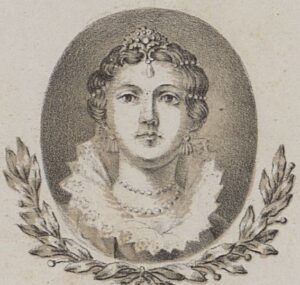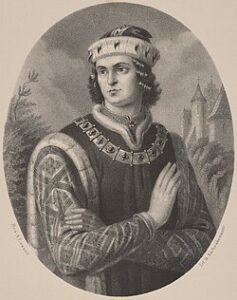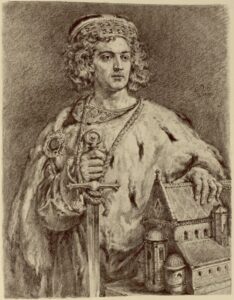Her name sounds regal, yet we know surprisingly little about her life. Wierzchosława, the wife of Duke Bolesław the Curly, remains a figure shrouded in mystery. Although she belonged to the innermost circle of power, she vanished from the annals of history as quietly as she entered them. But did she really leave nothing behind?
Wife from Novgorod the Great
Bolesław the Curly married twice. His first wife was a Ruthenian woman named Wierzchosława. She was the great-granddaughter of Vladimir Monomakh, one of the most powerful rulers of Kievan Rus, and the only daughter of Vsevolod Mstislavich, Prince of Novgorod. It is believed she was a year younger than Bolesław, possibly born no earlier than 1123, as that was when Vsevolod married. Unfortunately, nothing is known about the early years of her life. All we know is that she had two brothers, Ivan and Vladimir. Due to a lack of sources, we also cannot determine what kind of relationship she had with her siblings.
According to Jan Długosz, the wedding of Bolesław the Curly and Wierzchosława took place in Cracow. We cannot confirm or deny this information. “The Hypatian Chronicle” records that Wierzchosława married in 1137. Some historians have suggested moving this date back by as much as two years. Given the young age of the couple, it is assumed that the marriage was arranged by their parents. The only question is which side – Polish or Ruthenian – initiated the negotiations. It is impossible to say how long these talks lasted. The union with a Ruthenian princess, for obvious reasons, greatly increased Bolesław’s prestige, especially since his half-brother Władysław the Exile had long been married and already had children.
Bolesław’s marriage to Wierzchosława coincided with her father’s loss of power in Novgorod the Great at the hands of the boyars. According to sources, Vsevolod’s downfall was linked to conflicts he provoked and defeats suffered in wars with neighboring rulers. As compensation, the Grand Prince of Kiev, Iaropolk, granted Wierzchosława’s father the Principality of Vyshgorod. In 1137, Vsevolod found himself in Pskov, but he did not manage to reclaim Novgorod, as he died soon after. What happened to Vsevolod must have filled his daughter’s heart with sorrow. It is unclear whether these events took place before or after her marriage to the Piast duke. One could argue that had the Novgorod princess not come to Poland, she might have shared her father’s fate, whose last years were marked by misfortune. For Wierzchosława, however, things took a very different turn.
The reasons behind the Polish-Novgorodian rapprochement are unknown. Historians have proposed several competing theories. Currently, the theory of K. Maleczyński remains popular; he believed that the alliance with Vsevolod was meant to protect the Piast state from potential aggression by princes of southeastern Rus and Grand Prince Iaropolk of Kiev. Additionally, Bolesław the Wrymouth, by marrying his son to Wierzchosława, could count on support from her father in the event of war with the hostile Árpád and Přemyslid dynasties.
At one time, the view that an alliance with Novgorod the Great would provide Bolesław the Curly with real support in case of conflict with Władysław the Exile gained much traction in historiography. However, this thesis has no basis in the sources. It is difficult to assume that Boleslaw’s father, having drawn up his will, anticipated open war between his sons and sought allies for them. In reality, Bolesław the Curly could not count on help from his father-in-law, as Vsevolod died soon after. And when the Ruthenians attacked Mazovia in 1142, Bolesław had to face the foreign invasion alone.

In the Land of the Piasts
After the death of Bolesław the Wrymouth in 1138, Wierzchosława formally became Duchess of Mazovia and Kuyavia. Her daily life revolved around the court, which was likely based in Płock. In 1141, a gathering was held in Łęczyca at the initiative of the dowager duchess Salomea, who invited her sons, Mieszko the Old and Bolesław the Curly, along with their wives. During this meeting, the future of three-year-old Agnes, daughter of Bolesław the Wrymouth, was discussed. Initially, Salomea planned to place the princess in a convent, but later changed her mind and intended to marry her off to one of the Rurikids, probably Sviatoslav, son of Vsevolod Olegovich. This candidate may have been suggested to her mother-in-law by Wierzchosława, who was present in Leczyca and well acquainted with Rus and its political realities.
A pivotal moment in Wierzchosława’s life came in 1146. After a protracted civil war, which ended in a crushing defeat for Wladysław II the Exile – who was forced to flee Poland for Germany – Cracow fell into the hands of the victorious Bolesław the Curly. It was likely here that he settled permanently, accompanied by his wife. From then on, the Ruthenian princess became the undisputed leading lady in the divided Polish kingdom. Her husband’s authority now extended, in addition to Mazovia and Kuyavia, over the seniorate province taken from Władysław, as well as Silesia.
Wierzchosława’s heart must have pounded even harder later that same year, when a German expedition set out against Bolesław the Curly, led by King Conrad III. Władysław the Exile, relentless in his efforts to reclaim his lost throne, persuaded the German ruler to intervene militarily in the east. However, the Germans did not fare well in their campaign against the new senior of the Piast dynasty. As a result, they returned home only after Boleslaw paid them a hefty ransom. Polish-German relations deteriorated again when Frederick Barbarossa, successor to the late Conrad III, took power in the Holy Roman Empire in 1152. In 1157, responding to Władysław the Exile’s pleas, the new emperor launched another intervention in the east. Unlike the campaign of 1146, the German forces performed much better, aided in part by Bolesław the Curly himself, who chose not to defend key Polish strongholds on the Oder – such as Bytom Odrzański, Głogów and others.
As a result, the Germans reached Greater Poland with ease. In Krzyszkowo near Poznań, Bolesław, during a special ceremony, fell at the emperor’s feet, begging for forgiveness. The emperor magnanimously granted the Piast’s request and recognized his sovereignty over Poland. The withdrawal of imperial troops from Poland must have brought relief to Wierzchosława, who, in the worst-case scenario, could have lost power along with her husband. In the end, the couple managed to retain their rule.

Was the marriage of Bolesław the Curly and Wierzchosława a happy one? It is difficult to answer this question, as we do not know how their relationship unfolded. Jan Długosz, writing centuries later, spoke of Boleslaw’s attachment to his wife and their good relations. Although historians generally treat Długosz’s other information about the Curly’s marriage with skepticism, they are inclined to believe this particular claim. Vsevolod’s daughter accompanied her husband practically from the very beginning of his political career. No source mentions that Bolesław ever sent her away from court or that there were any disputes between them.
See also: The Third Queen of Poland – The Wife of Bolesław the Generous
The End of the Marriage
The marriage of Bolesław the Curly and Wierzchosława ended after several decades with the Ruthenian princess’s death. According to Jan Długosz, Wierzchosława’s passing deeply affected the widower, who struggled for a long time to recover from the loss. While this is plausible, it is harder to accept the chronicler’s claim that the duchess died in childbirth after giving birth to their second son, Leszek, in 1158. As historians have noted, this date was fabricated by Długosz, who also incorrectly dated Wierzchosława’s marriage to Bolesław (1151).
The exact date of Wierzchosława’s death is recorded in the so-called “Lubiń Necrology” – March 15. The duchess must have died before 1167, as a document from that year records an exchange of two villages with the Cracow chapter by Bolesław the Curly’s second wife, Maria. The place of Wierzchosława’s burial is unknown. The fact that only the Lubin necrology notes her death, while neither she nor her husband are mentioned in the Cracow annals, suggests that the Ruthenian princess was buried in the cathedral at Płock.

After his wife’s death, Bolesław the Curly, wishing to commemorate her, donated a silver-bound gospel book to the monastery of the Canons Regular in Czerwińsk, commonly known as the Gospel of Anastasia. This gospel remained in the Czerwińsk monastery until the 19th century, after which it was transferred to the library of the Society of Friends of Science in Warsaw (1831). After the fall of the November Uprising, the work ended up in the Imperial Public Library in St. Petersburg. The Gospel of Anastasia returned to Poland in 1921. Today, it is held in the collections of the National Library in Warsaw.
The Gospel measures 30.5 by 20 cm and consists of over 60 leaves containing various gospel texts. The front cover depicts the crucified Jesus Christ, flanked by Mary and St. John. At Christ’s feet kneels a woman, identified by specialists as Anastasia, that is, Wierzchosława. This is the only surviving portrait of Bolesław the Curly’s wife. The existence of this gospel may indicate the rich cultural and, above all, spiritual life of Wierzchosława.
See also: The Mysterious Wife of Mieszko Bolesławowic
Wierzchosława’s Children
Bolesław the Curly and Wierzchosława had several children, although determining the exact number of offspring from this marriage is quite difficult. The ducal couple likely had more children, but their deaths in infancy or early childhood meant that information about them did not make it into medieval chronicles.
Wierzchosława’s eldest son was Bolesław Bolesławowic, born around 1140. He was named after both his father and grandfather. From an early age, he was trained in the art of war, as evidenced by his participation in the 1166 campaign. His untimely death in 1172 must have grieved Wierzchosława. The loss of such a promising son likely also affected his ailing father, who died a few months later (1173). Some historians believe that the Curly’s sudden death was a psychological consequence of his son’s demise.
Wierzchosława bore Bolesław the Curly another son – Leszek. According to researchers meticulously studying the Piast genealogy, he was born between 1160 and 1165. Leszek suffered from poor health throughout his life, which did not prevent him from leading Mazovian troops to Rus (ca. 1178). He died a few years later (1186), as recorded in the “Annals of the Chapter of Cracow”.
A Piast princess, unnamed in the sources but mentioned in the “Polotsk Chronicle” and married to Prince Vasylko of Drohiczyn, was identified by leading Polish genealogists O. Balzer and K. Jasiński as a daughter of Bolesław the Curly. Although her mother is not named, the timing of her marriage (ca. 1173) suggests that Wierzchosława must have been her mother. This Piast princess was probably younger than Bolesław Bolesławowic. Nothing concrete is known about her life with the Ruthenian prince, her death, or her burial place.
See also: Who was Dobroniega Maria, the wife of Casimir the Restorer?
Some scholars believe that Wierzchosława bore Bolesław the Curly yet another daughter, named after her mother. All that is known about her is that she became a nun at Strzelno and died after 1213.
Bibliography:
-Barański M.K., Dynastia Piastów w Polsce, Warszawa 2005.
-Benyskiewicz K., Piastowie i Rurykowice. Polsko-ruskie stosunki polityczne od X do połowy XII wieku, Zielona Góra 2020.
-Biniaś-Szkopek M., Bolesław IV Kędzierzawy – książę Mazowsza i princeps, Poznań 2009.
-Biniaś-Szkopek M., Działalność fundacyjna i donacyjna Bolesława IV Kędzierzawego, „Przegląd Naukowo-Metodyczny. Edukacja dla Bezpieczeństwa” 2009, nr 1.
-Biniaś-Szkopek M., Dzielnica Bolesława Kędzierzawego w testamencie Krzywoustego, [w:] Cognitioni gestorum. Studia z dziejów średniowiecza dedykowane prof. J. Strzelczykowi, red. D.A. Sikorski, A.M. Wyrwa, Poznań–Warszawa 2006.
-Biniaś-Szkopek M., Konflikty w łonie dynastii piastowskiej a wzrost znaczenia możnych na przykładzie sporów synów Bolesława Krzywoustego, [w:] Pierwsze polsko-czeskie forum młodych mediewistów. Materiały z konferencji naukowej, Gniezno, 27–29 września 2005, red. J. Dobosz, J. Kujawiński, M. Matla-Kozłowska, Poznań 2007.
-Delimata M., Dziecko w Polsce średniowiecznej, Poznań 2004.
-Dobosz J., Bolesław IV Kędzierzawy, [w:] Słownik władców polskich, red. J. Dobosz, Poznań 1997.
-Dworsatschek M., Władysław II Wygnaniec, Kraków 2009.
-Jasiński K., Rodowód pierwszych Piastów, posł. T. Jurek, Poznań 2004.
-Karpiński R., Bolesław IV Kędzierzawy 1146–1173, [w:] Księga królów i książąt polskich, red. S.K. Kuczyński, Warszawa 1999.
-Labuda G., Zabiegi o utrzymanie jedności państwa polskiego w latach 1138–1146, „Kwartalnik Historyczny” 1959, R. 66, nr 4.
-Maleczyński K., Bolesław III Krzywousty, Wrocław 1975.
-Miśkiewicz B., Najazd Fryderyka Barbarossy na Polskę w roku 1157, [w:] idem, Szkice z dziejów wojskowości, Warszawa–Poznań 1991.
-Miśkiewicz B., Walki wewnętrzne na terenie Polski w latach 1142–1146, [w:] idem, Szkice z dziejów wojskowości, Warszawa–Poznań 1991.
-Wasilewski T., Bolesław IV Kędzierzawy, [w:] Poczet królów i książąt polskich, red. A. Garlicki, Warszawa 1978.
-Weber M., Statut Bolesława Krzywoustego w świetle źródeł, „Nasze Historie” 2001, t. 6.
-Włodarski B., Ruś w planach politycznych Bolesława Krzywoustego (1102–1138), „Zeszyty Naukowe Uniwersytetu Mikołaja Kopernika w Toruniu. Nauki Humanistyczno-Społeczne, Historia” 1966, z. 2(20).
-Włodarski B., Sojusz dwóch seniorów (ze stosunków polsko-ruskich w XII wieku), [w:] Europa – Słowiańszczyzna – Polska. Studia ku uczczeniu profesora Kazimierza Tymienieckiego, red. J. Bardach i in., Poznań 1970.
Author: Gabriela Zapolska